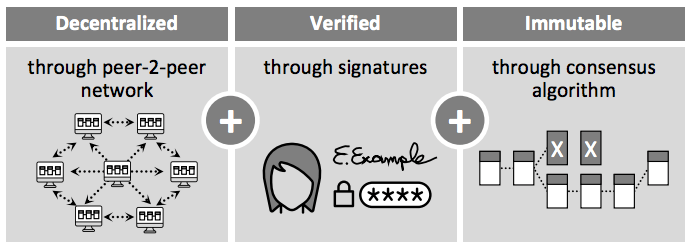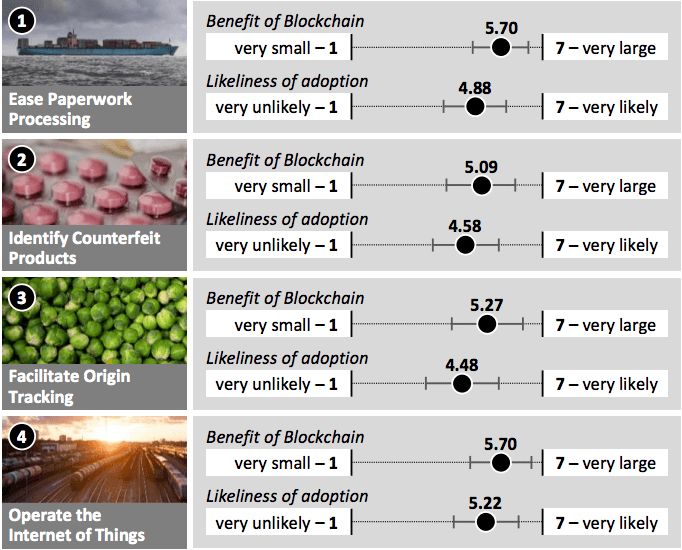Preventing the next E. Coli outbreak with Blockchain

In 2016, 55 people were infected by E. Coli after eating food at Chipotle Mexican Grill. Walmart doesn’t want to be the next Chipotle and they are using Blockchain to ensure they don’t.
One day you are eating a juicy pork burrito and the next you are turned over with stomach cramps and bloody diarrhea [1]. You have E. Coli. E. Coli can kill you.
In January 2016, the Center for Disease Control reported that at least 55 people were infected with an outbreak of E. Coli caused by food at Chipotle Mexican Grill [2]. After a thorough investigation of Chipotle’s supply chain, the U.S. Food and Drug Administration was not able to identify the origin of the outbreak [2]. Chipotle closed 43 restaurants in Washington and Oregon [2] and their stock tumbled over 44% [3].
Food supply is no easy business and the risk of a foodborne disease outbreak weigh heavy on any food supplier. Walmart, which runs a complex network of farmers, brokers, distributors, processors, retailers, and regulators, to deliver food to over 290 million consumers per week, does not want to become the next Chipotle [4]. Walmart’s management team is experimenting with Blockchain technology to bring transparency to the flow of the food in their supply chain and prevent a foodborne illness emergency [5].
Blockchain, the open source technology underpinning Bitcoin, is a distributed ledger and can be used to augment a supply chain’s database management system. Blockchain provides a supply chain with three core value propositions: decentralization, verification, and immutability [6].

Together these three value propositions bring reliability and transparency to the supply chain in a way that has never been available before. Blockchain creates a shared forum for all supply chain members to see the flow of inventory as soon as the inventory moves from one location in the chain to another.
In 2016, Walmart partnered with IBM to implement Blockchain in a test pilot. Before starting the pilot, Walmart executives took a box of Mangoes from a store location and asked their team to find where the mangoes came from. It took the team six days, 18 hours and 26 minutes to find the Mangoes’ origin [5]. There was a lot of room for improvement.
Walmart implemented Blockchain by scanning each palette of Mangoes as they move through the supply chain: from farmer to processor to distributor, and eventually, to the retail location. At each checkpoint the palettes were recorded in the Blockchain. IBM built the cloud infrastructure and front end application to monitor the Mangoes as they moved through the chain.
After successfully implementing, Walmart executives took a box of Mangoes to their latest shareholder meeting. They demonstrated finding the origin of the Mangoes in two seconds [5].
Using Blockchain technology, Walmart management created an immediate view into the flow of their food supply. Regulators can now use this data to quickly identify the origins of food outbreaks [5]. Without Blockchain technology it took the team over six days. With Blockchain it took two seconds.This is the difference between a Chipotle level emergency and completely containing a disease outbreak.
Using Blockchain to facilitate origin tracking is only the first in a long list of steps Walmart management should consider using in the next few years. Researchers from Kühne Logistics University identified four additional benefits of Blockchain [6]. They surveyed supply chain professionals on the perceived benefit and their likelihood of adopting Blockchain in their supply chain systems.

The results show general optimism, but also a trend in the industry to be cautious in adopting a new technology [6]. Walmart should buck this trend by adopting Blockchain in other areas of their supply chain, including tracking non-food products.
In the next ten years Walmart can become the industry leader in implementing Blockchain throughout the rest of their supply chain. The transparency will lead to supply chain optimizations, improved supplier relationships, and a reduction in inventory waste [5].
Walmart will save consumers lives by using Blockchain to monitor their food supply chain. If an outbreak occurs, management can quickly identify the origin of the outbreak and shut down that part of the chain. The technology is game changer for Walmart and as they continue to invest in other areas of the supply chain they will deliver more value to their customers.
A few open questions remain. Where should Walmart prioritize experimenting with Blockchain next? How can Walmart create a competitive advantage with their Blockchain implementation?
(718)
References
- Centers for Disease Control and Prevention, “General Information on E. Coli” https://www.cdc.gov/ecoli/general/index.html, accessed November 2017.
- U.S. Food and Drug Administration, “FDA Investigates Multistate Outbreak of E. coli O26 Infections Linked to Chipotle Mexican Grill Restaurants” https://www.fda.gov/food/recallsoutbreaksemergencies/outbreaks/ucm470410.htm, accessed November 2017.
- Authors of Wall Street Journal, “Chipotle Mexican Grill, Inc. CMG”, http://quotes.wsj.com/CMG, accessed November 2017.
- Hackett, Robert, “Walmart and 9 Food Giants Team up on IBM Blockchain Plans”, http://fortune.com/2017/08/22/walmart-blockchain-ibm-food-nestle-unilever-tyson-dole/, accessed 2017.
- Hackett, Robert, “Why Big Business Is Racing to Build Blockchains”, http://fortune.com/2017/08/22/bitcoin-ethereum-blockchain-cryptocurrency/, accessed November 2017.
- Hackius, Niels & Petersen, Moritz. Blockchain in Logistics and Supply Chain: Trick or Treat? In Hamburg International Conference of Logistics, At Hamburg, Germany, Volume: Digitalization in Supply Chain Management and Logistics October 2017.
- Hackett, Robert, “Walmart and IBM Are Partnering to Put Chinese Pork on a Blockchain”, http://fortune.com/2016/10/19/walmart-ibm-blockchain-china-pork/, accessed November 2017.
- Kharif, Olga, “Wal-Mart Tackles Food Safety With Trial of Blockchain”, https://www.bloomberg.com/news/articles/2016-11-18/wal-mart-tackles-food-safety-with-test-of-blockchain-technology, accessed November 2017.



I am reminded here of our Beer Game and Barilla Spa cases, which has led me to a few questions.
First, while utilizing blockchain in this context seems abundantly appropriate, how huge are the costs to implement? I would assume that a huge company like Walmart would have the funds to invest in this technology, but smaller companies may not have the capital to implement such a change.
Second, will there and can there be trust issues along the supply chain? As we discussed in our recent TOM class, even with the proliferation of technology today, companies upstream and downstream still hesitate to be transparent even at the cost of lost value and efficiency throughout the supply chain. However, based on Walmart’s case, it appears that retailers and suppliers have been open to discussions on blockchain [1] Though, if you’re a Walmart supplier, you probably have very little bargaining power, and would conform to Walmart’s ideas to keep your business with the giant.
[1] Forbes, “Walmart and 9 Food Giants Team Up on IBM Blockchain Plans” http://fortune.com/2017/08/22/walmart-blockchain-ibm-food-nestle-unilever-tyson-dole/ Accessed November 27, 2017.
Fascinating! I suffered during the great Chipotle Closure of 2016, not having access to my favorite fast casual restaurant was painful. Seeing Chipotle let its customers down was disappointing.
On a serious note, I had never guessed blockchain could be implemented within the context of a supply chain to track and verify goods, but the implications are now clear. Permanent, immutable, and instantaneously retrievable knowledge of exactly when and where an item has been has tremendous implications. Better quality control, lower overhead costs, and better management of recalls.
I also see applications in other food sectors, such as seafood origin and authenticity tracking. “Fake” and illegal seafood is a huge problem in the food industry and at this point in time almost impossible to fix. Aside from DNA testing, there is not real way to verify whether your Costco 5 lb family pack of frozen cod is actually cod. World fish stocks are severely threatened from unauthorized fishing fleets that catch fish outside of fishing season, severely hurting their ability to reproduce[1]. Requiring legal fishing fleets to use blockchain to track their catch could make it much easier for reputable companies (like Costco) to only source seafood with a verifiable chain.
[1]http://worldoceanreview.com/en/wor-2/fisheries/illegal-fishing/
Great read! The business case is compelling, but I think the challenge will be diffusing this innovation and taking it from one-off experiments/trials to a scaled solution. A few things that I believe would help increase adoption is:
1) Incorporating and communicating even more benefits. Since blockchain is still an earlier-stage technology, I see opportunity for food companies to work with developers to shape it to deliver even more benefits to encourage adoption. For example, food companies have expressed interest in being able to track other attributes in addition to origin, such as temperature, quality standards, and safety certifications [1]. In the case of bacteria outbreaks, I could see this additional information being useful in unpacking not only where the problem occurred, but also why it occurred.
2) Add more use cases to defray costs of development/implementation. As you mentioned in your piece, there are other uses for blockchain. In response to your question about what experiments Walmart should prioritize next, I see a compelling synergy in using blockchain to reduce paperwork on international freight, which would decrease cost [6] and complement the tracking of food items.
3) Engage and educate middle managers. While c-level executives were more optimistic about the benefits of blockchain, middle managers were much less so [6]. Rolling out blockchain at a meaningful scale would require a robust change management effort, and likely involve a longer process of educating middle managers on the benefits of blockchain and giving them opportunities to somehow try it for themselves.
This was so interesting to read – thanks Wade! I had never considered before how blockchain could be applied to the food industry. You set out very clearly this ‘Blockchain of Food’ can allow companies such as Walmart to verify the source and quality of its goods and quickly identify weak links in times of crisis.
This technology could also be a very powerful tool in combating food fraud. In 2013, the UK and Europe were hit by what has since become known as the ‘horse meat scandal’: foods advertised as beef products were actually found to contain horse meat (or even to be 100% comprised of horse meat in some cases!) [1]. Unlike the Chipotle incident, this wasn’t just an instance of quality control, but of potential criminal activity in food production. In cases such as this, the application of blockchain technology to food supply chains can be incredibly valuable not only to private companies, but also to regulators and/or government bodies monitoring the risk of food crime.
[1] https://en.wikipedia.org/wiki/2013_horse_meat_scandal
Very interesting article! I hadn’t appreciated the implications of Blockchain technology in this way, but clearly makes a lot of sense and ultimately benefits the consumer and retailer greatly.
One concern I have is that it is still early days for Blockchain technology and could be years until retailers actually see benefits from this technology. Another question that comes to mind is understanding how to incentive the entire supply chain to adopt the technology and how costly and difficult implementation would be. Would Walmart (or other retailers) be able to share some of the cost with suppliers rather than bearing the burden alone? That said, given the immense benefits to both the consumer and the entire supply chain, I am hopeful!